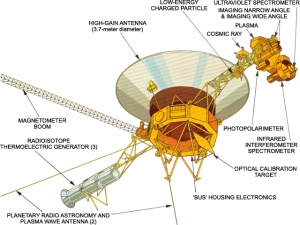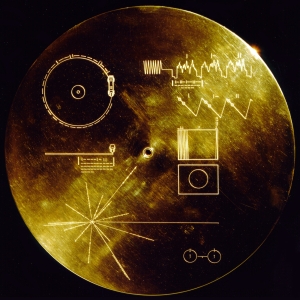


If The Legend of Bagger Vance and the game of golf can be considered a metaphor for life, and it, along with such golf movies as Tin Cup and Seven Days in Utopia, surely can be, then perhaps the venerable Voyager 1 space probe can be considered as being somewhat analogous to aging.
On Sept. 5, 1977, the Voyager 1 space probe launched from Cape Canaveral, Florida aboard a Titan-Centaur rocket. A 12-inch gold-plated copper disc stored aboard the probe contains greetings in 60 languages, samples of music from different cultures and eras, and natural and man-made sounds from Earth. They also contain electronic information that an advanced technological civilization could convert into diagrams and photographs.
Voyager 1’s primary mission was completed 12 years later in 1989 when it completed its planned close flybys of the Jupiter and Saturn planetary systems. Its extended Voyager Interstellar Mission objective is to extend the National Aeronautics and Space Administration (NASA) exploration of the solar system beyond the neighborhood of the outer planets to the outer limits of the Sun’s sphere of influence, and possibly beyond.
In August 2012, Voyager 1 flew beyond Termination Shock, the point where the solar wind becomes slower than the speed of sound, and crossing the heliopause boundary, and finally entering interstellar space, making it the first human-made object to explore this new territory. Its Mission Elapsed Time is now 45 years, seven months, and 22 days.
The existential point of Voyager 1 is it keeps on going. Aging is similar to that. In some ways, you move beyond the playbook but keep, by the grace of God, and genes, on going. That can be both liberating and terrifying. In a post last July (https://soundingsjohnbarker.wordpress.com/2022/07/05/character-courage-redemption-and-some-thoughts-on-aging-gracefully-aging-well-hint-mellow-isnt-just-for-coffee-and-gratitude-really-is-an-attitude/), I wrote about aging gracefully, aging well.
“My own thoughts on aging gracefully, aging well, might be summarized thusly: Be mellow, be grateful,” I wrote two days before I knew I was going to have a cystoscopy for kidney stones at Health Sciences Centre (HSC) in Winnipeg. Perhaps it was meant as much as a 48-hour countdown clock pep talk to myself as anything. Because after the cystoscopy most of the grace I felt for the remainder of the day was fentanyl-fueled by my merciful urology surgeon, who discharged me from day surgery with an admonition to my medical escort that I not be allowed to sign any legal documents or venture into a casino for at least 24 hours. He also cautioned my medical escort that my memory would be on a five-minute fentanyl-inspired repeating question loop for the rest of the day. All in all, I’d say, doc was pretty close to the mark. On the good side, I sat obediently on a curb outside HSC in the wonderful, warm Winnipeg July sunshine, while Jeanette retrieved the vehicle from a nearby parkade. And I did this even though a beckoning lunch-hour hot dog cart was mere feet away. Later, minutes before closing time, we made our first trip together to the Polo Park shopping centre since long before the COVID-19 pandemic began. Jeanette says I raced along both the lower and upper levels of the mall at record race walking speed, compared to my often spine-challenged limp.
On the not-so-good side, I asked detailed questions of my medical escort about my urology procedure on the HSC elevator down to the ground floor. When I wasn’t satisfied with the answers I was getting, I helpfully suggested that perhaps the answers I was receiving were not adequate. Once we arrived at Grand Medicine Health Sciences Pharmacy to get a couple of prescriptions filled, I had a pleasant, albeit apparently rather loud, telephone conversation with an agent of Manitoba Blue Cross about the summer status of my plan coverage. Later, we had a lovely dinner with Jeanette’s son, Robin, and his wife, Chelsie, on the patio of Damecca Lounge on Madison Street in Winnipeg. As the meal ended, I wandered inside without a word to anyone, leaving them to assume that I had just had to use the washroom, but instead I picked up the tab (good) but only initially inadvertently left a $0.26 tip for our more-than-competent waiter on the point-of-sale terminal he had handed to me (bad). Fortunately, I realized my faux pas (perhaps the look on his face?), and fortuitously had some paper fiat currency in my wallet to hand over also. Needless to say, I didn’t visit any casinos.
As it turned out, the summer would be much more difficult than the initial July 7 trip. Between the end of July and mid-September, I would be make six trips the Emergency Department of Thompson General Hospital – more than my previous combined total in 15 years of living in Thompson – as well as making two more road trips to Winnipeg’s Health Sciences Centre for more related day surgeries on July 20 and Sept. 16. In that short space of time, I had gone from being triaged as a patient to be seen sooner-than-later to the top of the provincial urology surgery list.
My trusty medical escort assures me that my loud and repeated use of the f-word all down the corridor, as I painfully walked back to our hotel room at 6 a.m. Saturday morning Sept. 17 at the Quality Inn & Suites on Pembina Highway, would have sufficed to have me tossing the guest out if I had been working the the front of desk of my own Quality Inn & Suites Thompson. The same could no doubt be attested to by three older ladies whom I shared an observation room with overnight at HSC in the preceding hours. One told a nurse making her rounds “the gentleman seems to be in quite a bit of pain,” as I stood beside my bed all night, as it was the most comfortable position of a bad lot of choices. The nurse replied, “We’ll be giving him something for the pain in a minute,” saying it with a tone suggesting a bit of silence would be a bonus for everyone, along with pain relief.
By the end of September, I would feel fine.
In the Knights of Columbus, our fraternal Latin motto is “tempus fugit, memento mori,” which translates in English to “time flies, remember death.” If I’m tempted to think myself above some tedious task, I usually catch myself and instead think something to the effect of, “Thank God that I am still blessed with the physical ability and and cognitive skills to perform do it.”
The late Vietnamese Buddhist monk Thích Nhất Hạnh, who died in January 2022, at the age of 95, had many useful things to say over many decades of teaching on mindfulness and seemingly ordinary and mundane tasks. And while I may not know many of today’s stars who make up what passes for celebrity culture in the present zeitgeist, I am not apparently a complete Luddite, as I am activating a JK hand-me-down digital iPhone 7 Apple smartphone, after about a 15-year hiatus from my old classic black Motorola 120c analog cell phone (which went through a full wash-and-dry cycle once, maybe twice, in a side pocket of some green khaki cargo shorts.)
I haven’t subscribed to 81-year-old Moses Znaimer’s Zoomer magazine yet, but it is only April and the year is still young.
You can also follow me on Twitter at: https://twitter.com/jwbarker22






